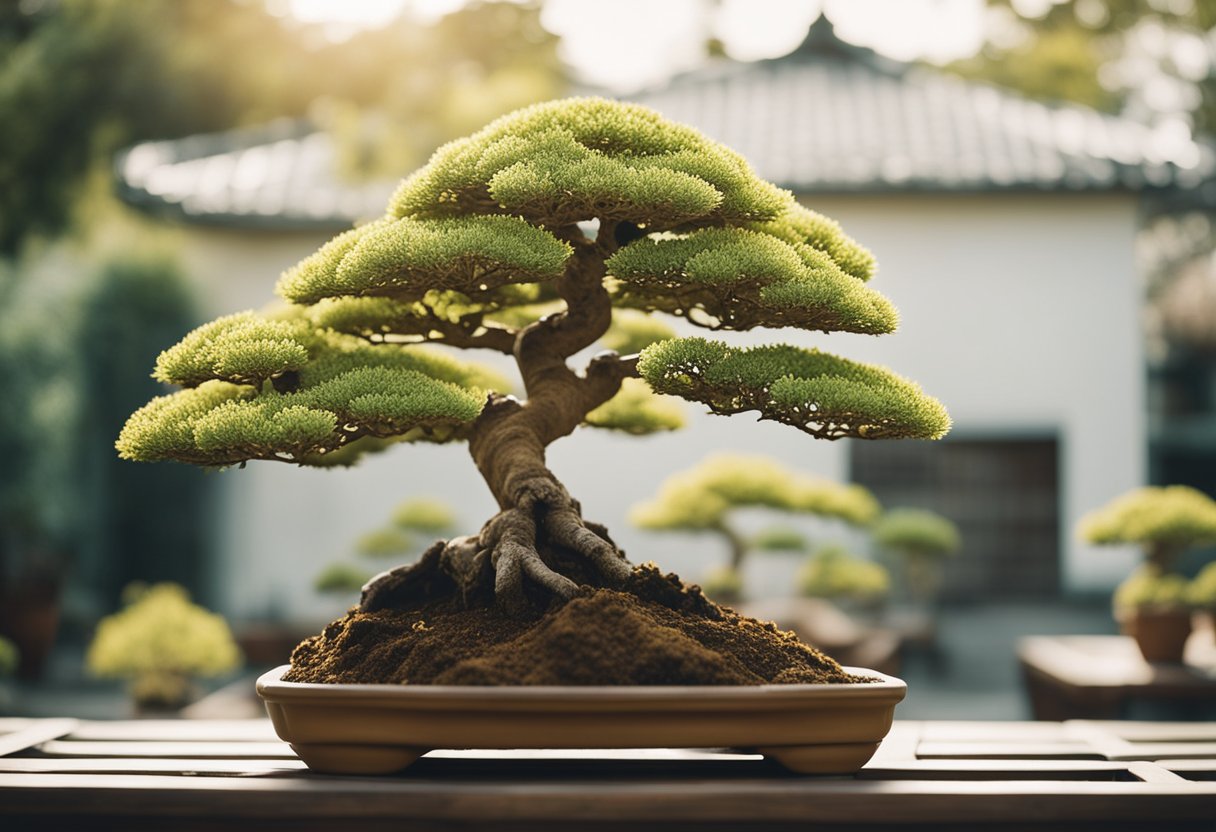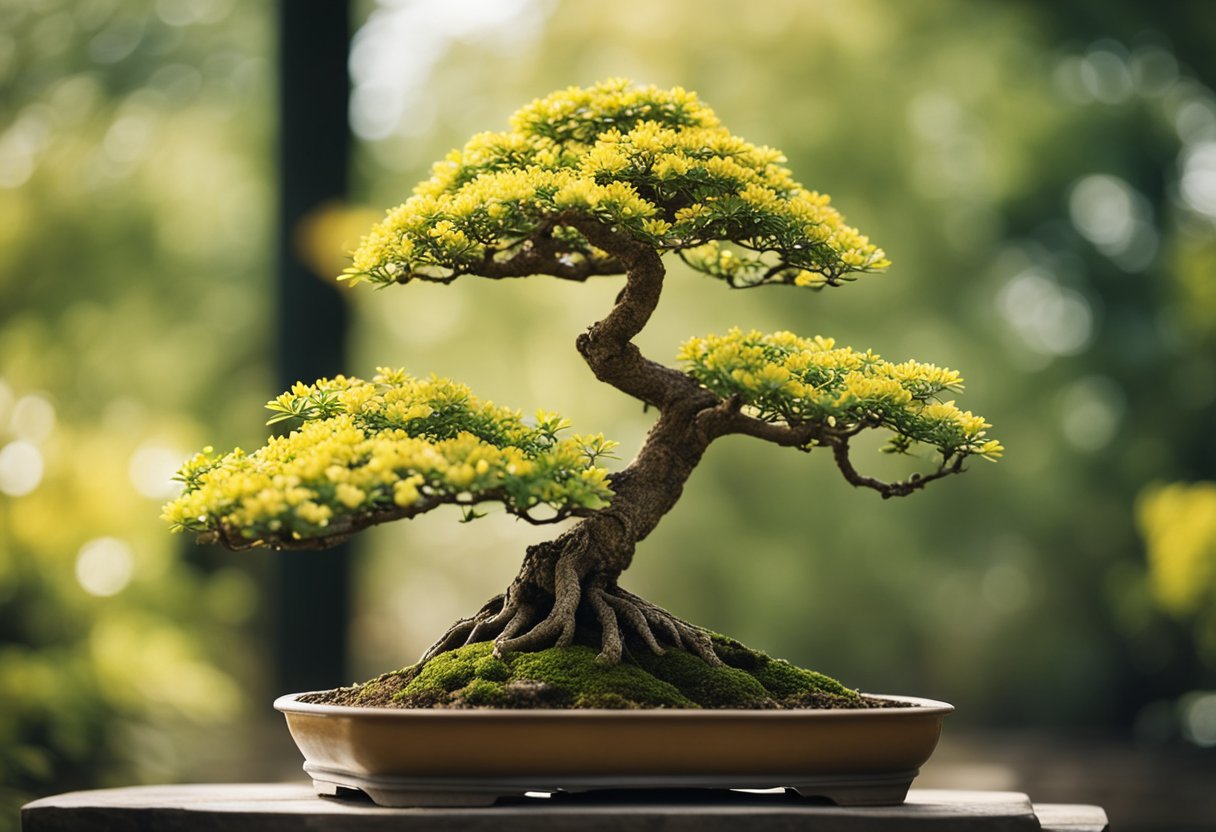Why Is My Bonsai Turning Yellow: Possible Causes and Solutions
Bonsai trees are a beautiful addition to any home, but it can be frustrating when they start to turn yellow. There are a few reasons why this might happen, and it’s important to identify the cause so you can take the appropriate action to save your tree.
This post may contain affiliate links, which means I’ll receive a commission if you purchase through my link, at no extra cost to you. Please read full disclosure here.

One common reason for yellowing leaves is overwatering or underwatering. Bonsai trees are small and can be easy to forget about, but they still require proper watering. If you overwater your tree, the roots can become waterlogged and start to rot, which can lead to yellowing leaves. On the other hand, if you underwater your tree, the leaves can dry out and turn yellow.
Another reason why your bonsai might be turning yellow is due to pests or disease. Spider mites, scale insects, and mealybugs are common pests that can infest bonsai trees and cause damage to the leaves. Diseases such as root rot or fungal infections can also cause yellowing leaves. Identifying the specific pest or disease is crucial in order to treat it effectively and save your tree.
Understanding Bonsai Yellowing

Bonsai trees are beautiful and delicate plants that require special care and attention. One of the most common issues that bonsai growers face is yellowing of the leaves. There are several reasons why a bonsai tree may start to turn yellow, and it is important to understand the underlying causes to address the issue effectively.
One of the most common causes of yellowing leaves in bonsai trees is overwatering or underwatering. Bonsai trees are small and can be easy to forget about watering them. However, no matter how expensive the bonsai soil is, the plant will eventually die if it is not watered properly. Overwatering can lead to root rot and other fungal diseases, which can cause the leaves to turn yellow. On the other hand, underwatering can cause the leaves to dry out and turn yellow.
Another reason why a bonsai tree may turn yellow is due to a lack of nutrients. Bonsai trees require specific nutrients to thrive, and a lack of these nutrients can cause the leaves to turn yellow. It is important to fertilize the bonsai tree regularly to ensure that it is getting the necessary nutrients.
Yellowing leaves can also be caused by pests and diseases. Common pests that can affect bonsai trees include aphids, scales, and mealybugs. These pests can cause stress on the plant, which can lead to yellowing leaves. It is important to inspect the bonsai tree regularly for signs of pests and to take action immediately if any are found.
Lastly, yellowing leaves can be a natural occurrence in some bonsai trees. If a tree is deciduous, it will turn yellow and shed some of its leaves in the autumn. If the tree looks yellow and dry in the leaves, it is important to determine the time of year. If it is autumn, then it might be going through its natural seasonal change.
In conclusion, yellowing of leaves in bonsai trees can be caused by several factors, including overwatering or underwatering, a lack of nutrients, pests and diseases, and natural seasonal changes. It is important to identify the underlying cause of the yellowing leaves to address the issue effectively and ensure the health and longevity of the bonsai tree.
Common Causes of Yellowing

Bonsai trees are delicate and require proper care to thrive. However, even with the best care, they can still develop yellow leaves. Here are some common causes of yellowing in bonsai trees:
Improper Watering
Improper watering is one of the most common causes of yellowing in bonsai trees. Overwatering, underwatering, or lack of water can all cause leaves to turn yellow. Bonsai trees require consistent and proper watering to maintain their health. It is recommended to use clean water or tap water that has been left to sit for 24 hours to allow chlorine to evaporate.
Inadequate Light Exposure
Bonsai trees require proper light exposure to thrive. Direct sunlight, indirect sunlight, or grow lamps can all provide the necessary light for bonsai trees. However, too much or too little light can cause leaves to turn yellow. It is important to provide the appropriate amount of light based on the species of tree and the environmental conditions.
Nutrient Deficiencies
Nutrient imbalances or deficiencies can cause leaves to turn yellow. Bonsai trees require proper nutrition to maintain their health. Fertilizers can provide the necessary nutrients such as nitrogen, phosphorus, potassium, and minerals. However, too much or too little fertilizer can cause nutrient imbalances and deficiencies, leading to yellowing leaves. It is important to use the appropriate fertilizer and follow the recommended application rates.
Poor Drainage and Root Rot
Poor drainage and root rot can cause yellowing in bonsai trees. Bonsai trees should be planted in appropriate bonsai soil with good drainage. The pot should have a drainage hole to allow excess water to drain out. Overwatering or improper watering can cause the roots to rot, which can lead to yellowing leaves. It is important to check the root system regularly and ensure proper drainage to prevent root rot.
Pests and Diseases
Pests or diseases can cause yellowing in bonsai trees. Insect infestations, such as aphids, spider mites, and scale insects, can cause yellowing leaves. Bacterial diseases, such as sap rot and mealybugs, can also cause yellowing leaves. It is important to identify and treat pests or diseases promptly to prevent further damage to the bonsai tree.
In conclusion, yellowing leaves in bonsai trees can be caused by a variety of factors, including improper watering, inadequate light exposure, nutrient deficiencies, poor drainage and root rot, and pests and diseases. Proper care and maintenance can help prevent yellowing leaves and ensure the health and longevity of bonsai trees.
Specific Bonsai Species and Yellowing
Different bonsai tree species may have different requirements and may be more prone to yellowing leaves than others. Deciduous bonsai trees, such as maples and elms, naturally lose their leaves in the fall and will have yellow leaves before they fall off. However, if the bonsai tree is evergreen and its leaves are turning yellow, it may be a sign of a problem.
Some evergreen bonsai tree species, such as junipers and pines, may turn yellow if they are overwatered or if they are not receiving enough sunlight. On the other hand, some houseplants that are commonly used as bonsai trees, such as the Ficus, may turn yellow if they are underwatered or if they are exposed to cold drafts.
It is important to research the specific requirements of the bonsai tree species that you have to ensure that you are providing it with the proper care. If you are unsure of the species of your bonsai tree, you can bring a sample of its leaves to a local nursery or bonsai expert for identification.
Overall, yellowing leaves on a bonsai tree may be a sign of a problem, but it does not necessarily mean that the tree is dying. With proper care and attention, most bonsai trees can recover from yellowing leaves and continue to thrive.
Preventive Measures and Solutions
To prevent your bonsai from turning yellow, proper care and attention are necessary. Here are some preventive measures and solutions that can help keep your bonsai healthy and vibrant.
Proper Watering and Drainage
One of the most important aspects of bonsai care is proper watering and drainage. Overwatering or underwatering can cause yellowing of the leaves. It is recommended to use clean water, preferably distilled, to avoid any chemical buildup in the soil. Tap water can also be used, but it should be allowed to sit for at least 24 hours to allow the chlorine to evaporate.
To ensure proper drainage, it is recommended to use a bonsai pot with drainage holes and a well-draining soil mix. A soil testing kit can be used to determine the moisture level of the soil. Generally, bonsai trees require watering when the soil is slightly dry to the touch.
Appropriate Light and Temperature
Bonsai trees require appropriate light and temperature to thrive. Insufficient light can cause yellowing of the leaves, while direct sunlight can scorch the leaves. It is recommended to place the bonsai in a location that receives indirect sunlight for at least 5 hours a day.
Temperature extremes can also cause yellowing of the leaves. Bonsai trees prefer a temperature range of 60-75°F (15-24°C). During the dormant period, the temperature can be lowered to 50-60°F (10-15°C).
Nutrition and Fertilizing
Bonsai trees require proper nutrition to maintain their health and prevent yellowing of the leaves. Fertilizers can be used to provide the necessary nutrients. It is recommended to use a balanced fertilizer, such as 10-10-10, every two weeks during the growing season.
Pest Control and Disease Prevention
Pests and diseases can also cause yellowing of the leaves. Regular inspection of the bonsai tree can help identify any signs of pest infestation or disease. Insecticide can be used to control pests, while proper pruning and repotting can prevent disease.
Pruning and Repotting
Pruning and repotting are essential to bonsai care and development. Pruning helps maintain the desired shape and size of the bonsai tree, while repotting provides fresh soil and promotes healthy root growth. Special tools, such as pruning shears and root hooks, can be used for pruning and repotting.
By following these preventive measures and solutions, bonsai owners can maintain the health and vibrancy of their bonsai trees and prevent yellowing of the leaves.
Conclusion
Taking care of a bonsai tree requires patience, attention to detail, and knowledge of the tree’s specific needs. If a bonsai tree is turning yellow, it is important to identify the underlying cause and take action to correct the issue.
Environmental stress, improper watering, and pests are common reasons why a bonsai tree may turn yellow. To prevent environmental stress, it is important to keep the tree in a location with consistent temperature and humidity levels. If the tree is exposed to extreme temperatures or drafts, it may become dehydrated and turn yellow.
Proper watering is also crucial for the health of a bonsai tree. Overwatering or underwatering can cause the leaves to turn yellow. It is important to water the tree when the soil is dry to the touch, but not to let it sit in standing water. Choosing the right pot for the tree can also help prevent root rot and other issues caused by improper drainage.
Pests can also cause a bonsai tree to turn yellow. Insects feeding on the tree’s sap can rob it of the resources it needs and cause stress, which will turn the leaves yellow. Inspecting the tree regularly for signs of pests and taking action to eliminate them can help prevent further damage to the tree.
Overall, taking care of a bonsai tree requires attention to detail and knowledge of the tree’s specific needs. By identifying the underlying cause of a tree turning yellow and taking action to correct the issue, bonsai enthusiasts can help ensure the health and longevity of their trees.